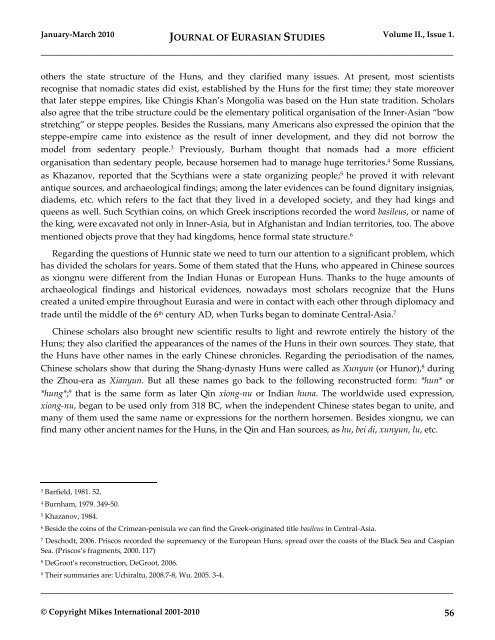EurasianStudies_0110..
EurasianStudies_0110..
EurasianStudies_0110..
You also want an ePaper? Increase the reach of your titles
YUMPU automatically turns print PDFs into web optimized ePapers that Google loves.
January-March 2010 JOURNAL OF EURASIAN STUDIES Volume II., Issue 1.<br />
_____________________________________________________________________________________<br />
others the state structure of the Huns, and they clarified many issues. At present, most scientists<br />
recognise that nomadic states did exist, established by the Huns for the first time; they state moreover<br />
that later steppe empires, like Chingis Khan’s Mongolia was based on the Hun state tradition. Scholars<br />
also agree that the tribe structure could be the elementary political organisation of the Inner-Asian “bow<br />
stretching” or steppe peoples. Besides the Russians, many Americans also expressed the opinion that the<br />
steppe-empire came into existence as the result of inner development, and they did not borrow the<br />
model from sedentary people. 3 Previously, Burham thought that nomads had a more efficient<br />
organisation than sedentary people, because horsemen had to manage huge territories. 4 Some Russians,<br />
as Khazanov, reported that the Scythians were a state organizing people; 5 he proved it with relevant<br />
antique sources, and archaeological findings; among the later evidences can be found dignitary insignias,<br />
diadems, etc. which refers to the fact that they lived in a developed society, and they had kings and<br />
queens as well. Such Scythian coins, on which Greek inscriptions recorded the word basileus, or name of<br />
the king, were excavated not only in Inner-Asia, but in Afghanistan and Indian territories, too. The above<br />
mentioned objects prove that they had kingdoms, hence formal state structure. 6<br />
Regarding the questions of Hunnic state we need to turn our attention to a significant problem, which<br />
has divided the scholars for years. Some of them stated that the Huns, who appeared in Chinese sources<br />
as xiongnu were different from the Indian Hunas or European Huns. Thanks to the huge amounts of<br />
archaeological findings and historical evidences, nowadays most scholars recognize that the Huns<br />
created a united empire throughout Eurasia and were in contact with each other through diplomacy and<br />
trade until the middle of the 6 th century AD, when Turks began to dominate Central-Asia. 7<br />
Chinese scholars also brought new scientific results to light and rewrote entirely the history of the<br />
Huns; they also clarified the appearances of the names of the Huns in their own sources. They state, that<br />
the Huns have other names in the early Chinese chronicles. Regarding the periodisation of the names,<br />
Chinese scholars show that during the Shang-dynasty Huns were called as Xunyun (or Hunor), 8 during<br />
the Zhou-era as Xianyun. But all these names go back to the following reconstructed form: *hun* or<br />
*hung*; 9 that is the same form as later Qin xiong-nu or Indian huna. The worldwide used expression,<br />
xiong-nu, began to be used only from 318 BC, when the independent Chinese states began to unite, and<br />
many of them used the same name or expressions for the northern horsemen. Besides xiongnu, we can<br />
find many other ancient names for the Huns, in the Qin and Han sources, as hu, bei di, xunyun, lu, etc.<br />
3 Barfield, 1981. 52.<br />
4 Burnham, 1979. 349-50.<br />
5 Khazanov, 1984.<br />
6 Beside the coins of the Crimean-penisula we can find the Greek-originated title basileus in Central-Asia.<br />
7 Deschodt, 2006. Priscos recorded the supremancy of the European Huns, spread over the coasts of the Black Sea and Caspian<br />
Sea. (Priscos’s fragments, 2000. 117)<br />
8 DeGroot’s reconstruction, DeGroot, 2006.<br />
9 Their summaries are: Uchiraltu, 2008.7-8, Wu. 2005. 3-4.<br />
_____________________________________________________________________________________<br />
© Copyright Mikes International 2001-2010 56

















